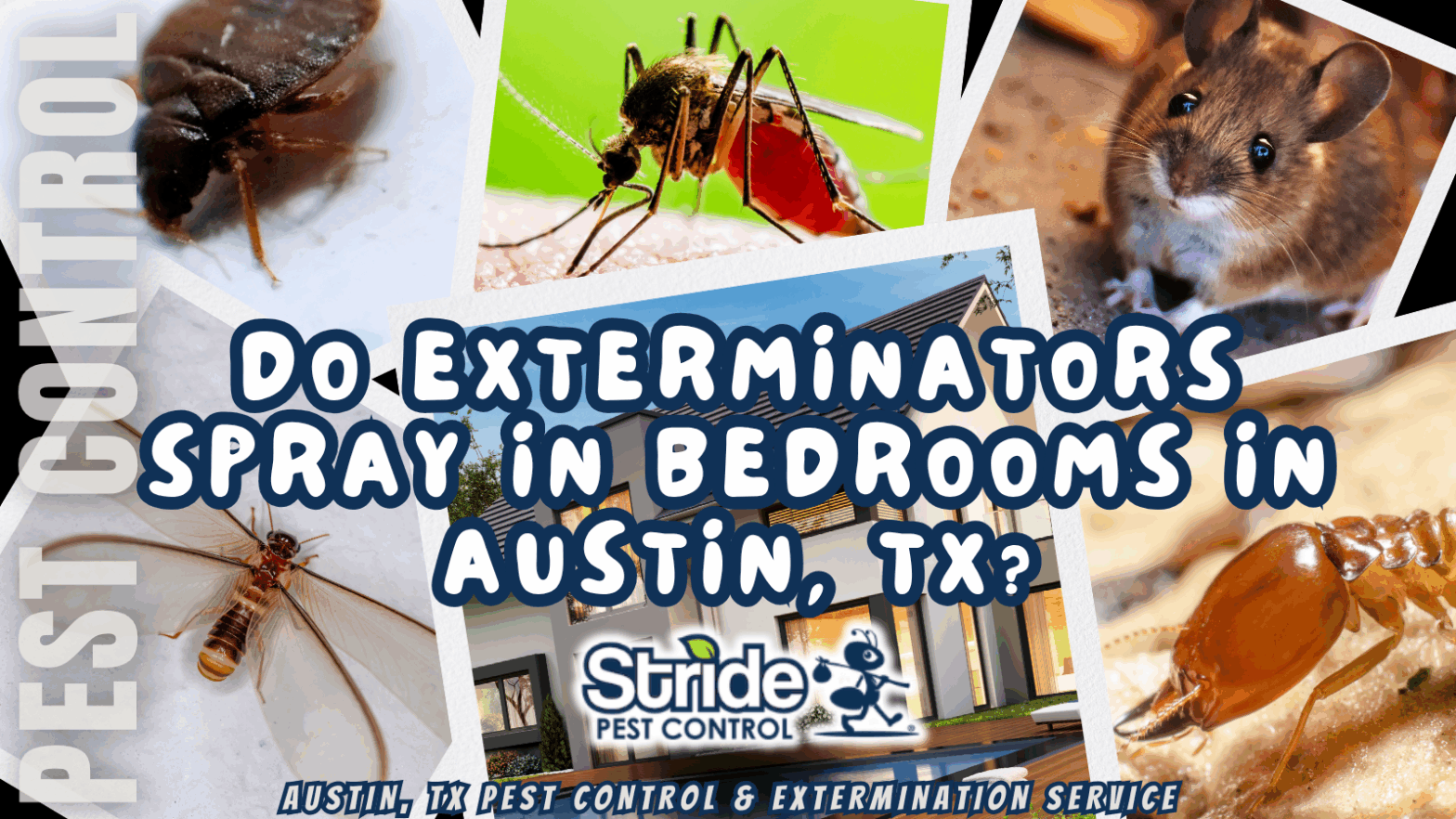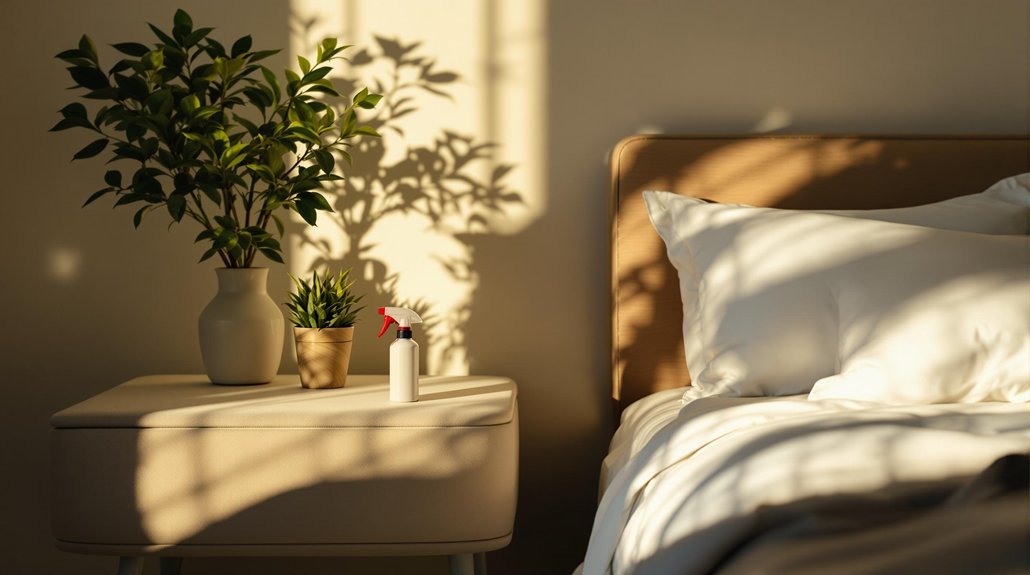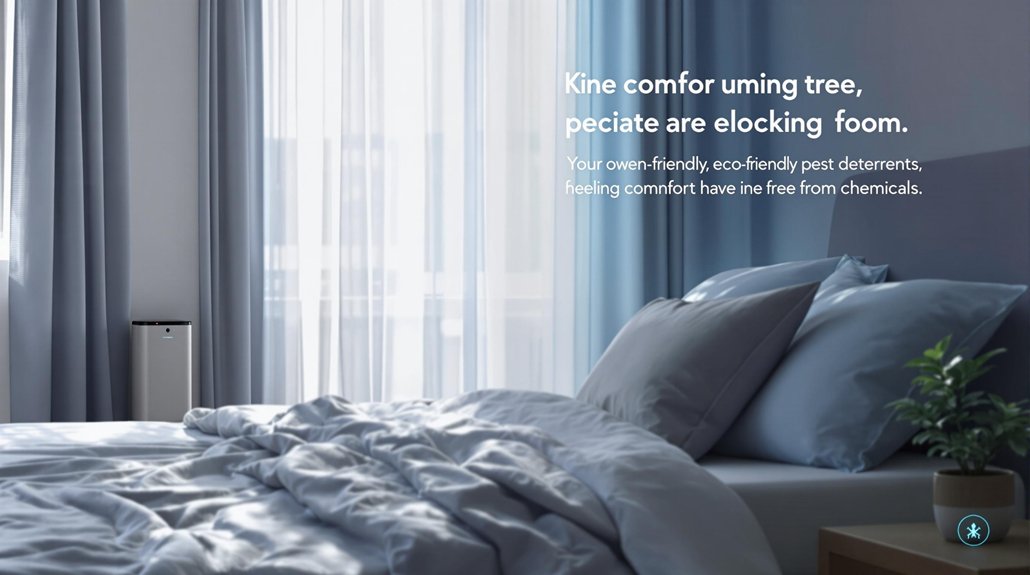
Exterminators in Austin often spray in bedrooms to combat pests like bed bugs and dust mites. This method targets areas where these pests hide, ensuring effective elimination. Safety protocols are followed, including using protective gear and keeping residents out during treatment. Alternatives to spraying exist, such as non-toxic methods and integrated pest management. Understanding these practices can help homeowners make informed decisions. Further information on pest control methods and preparation tips is available for those interested.
Key Article Highlights
- Yes, exterminators do spray in bedrooms as part of pest control treatment to eliminate infestations effectively.
- Targeted spraying in bedrooms addresses pests like bed bugs and dust mites hiding in mattresses and bedding.
- Exterminators follow safety protocols, ensuring residents vacate the treated areas during the spraying process.
- Clear communication with the exterminator about specific pest issues is essential for effective treatment in bedrooms.
- Regular cleaning and preparation, such as removing personal items, enhance the effectiveness of bedroom pest control treatments.
Understanding Pest Control Methods Used by Exterminators
When pests invade a home, understanding the methods used by exterminators can help homeowners make informed decisions. Exterminators use various pest control techniques to eliminate unwanted pests. These methods may include chemical sprays, traps, and baits. Chemical sprays are often applied to areas where pests are active. Traps are used to capture pests without chemicals. Baits attract pests to toxic substances. Each extermination method has its own advantages and disadvantages. Some methods are quick and effective, while others may take longer to show results. Homeowners should consider the safety of these methods, especially in living spaces like bedrooms. Knowing these pest control techniques empowers homeowners to choose the best solution for their specific pest problem. Additionally, many exterminators also utilize heat treatment as a highly effective method for eliminating bed bugs and their eggs. Exterminators often focus on entry points to ensure that pests do not re-enter the home after treatment. To further enhance their efforts, they may also implement standing water management to prevent mosquito breeding around the property.
Common Pests Found in Bedrooms
Bedrooms can become a target for various pests, making it important for homeowners to recognize these common intruders. One of the most notorious pests is the bed bug. These small, brown insects hide in mattresses and bedding, feeding on human blood. Their bites can cause discomfort and anxiety. Another common pest found in bedrooms is dust mites. These tiny creatures thrive in warm, humid environments and feed on dead skin cells. They are often found in bedding, carpets, and upholstered furniture. Dust mites can trigger allergies and asthma in sensitive individuals. Keeping bedrooms clean and well-maintained is essential to prevent infestations of bed bugs and dust mites. Regular cleaning can help maintain a pest-free living space. Additionally, implementing insect growth regulators can be an effective strategy for controlling pests in these areas. Utilizing liquid soil treatments can also help prevent pests like termites from invading your bedroom space. To ensure thorough protection, it is advisable to schedule routine inspections and seasonal adjustments for comprehensive pest control.
Reasons for Spraying in Bedrooms

Spraying in bedrooms is often necessary to control pest populations effectively. Many people overlook the bedroom, but it can be a hiding spot for pests. Addressing bedroom infestations is essential for overall home safety. Here are four reasons to take into account spraying in bedrooms:
- Preventing infestations: Early intervention stops pests before they multiply.
- Health risks: Pests can carry diseases that affect sleep quality and health.
- Spray effectiveness: Targeted spraying in bedrooms guarantees pests are eliminated where they hide.
- Peace of mind: A pest-free bedroom promotes relaxation and better rest.
Safety Protocols for Exterminators
Ensuring the safety of both exterminators and residents is essential during pest control procedures. Exterminators must adhere to strict safety protocols. These include wearing proper safety equipment and holding relevant exterminator certifications.
The following table outlines key safety protocols:
| Protocol | Description |
|---|---|
| Use of Safety Equipment | Gloves, masks, and goggles are mandatory. |
| Training and Certification | Exterminators must have up-to-date certifications. |
| Area Preparation | Residents should vacate treated areas. |
| Communication | Clear instructions must be provided to residents. |
Alternatives to Spraying in Sleeping Areas

When addressing pests in sleeping areas, there are safer options than spraying chemicals. Non-toxic treatment options can effectively reduce pest problems without harming residents. Additionally, integrated pest management techniques offer a holistic approach to pest control, focusing on prevention and monitoring. Utilizing residual sprays can be effective for treating pests in other areas of the home while keeping sleeping areas safe. Implementing exclusion repairs can further enhance safety by preventing pests from entering sleeping areas in the first place.
Non-toxic Treatment Options
While many traditional pest control methods involve spraying chemicals, there are effective non-toxic treatment options available for bedrooms. These alternatives can help keep pests away without harming the environment or sleeping areas.
- Natural Repellents: Essential oils like peppermint and lavender can deter insects.
- Diatomaceous Earth: This powder can safely eliminate pests by damaging their exoskeletons.
- Traps: Sticky traps can effectively catch pests without chemicals.
- Seal Cracks: Keeping doors and windows sealed prevents pests from entering.
These chemical alternatives provide safe solutions for those who want to maintain a pest-free space while prioritizing health and safety. Exploring these options can lead to effective pest control without the use of harmful substances.
Integrated Pest Management Techniques
Integrated Pest Management (IPM) offers practical alternatives to traditional spraying in sleeping areas. IPM focuses on integrated strategies for pest prevention that reduce reliance on chemical treatments. This method emphasizes understanding pest behavior and monitoring infestations. Simple practices include sealing entry points, maintaining cleanliness, and using traps.
What to Expect During a Pest Control Visit
A typical pest control visit involves several key steps to confirm effective treatment. Understanding pest behavior is vital in this process. The exterminator assesses the situation and determines the best course of action. The visit usually follows these steps:
A pest control visit includes inspection, assessment, treatment application, and follow-up to ensure effective pest management.
- Inspection: The exterminator looks for signs of pests and identifies entry points.
- Assessment: They evaluate pest behavior and decide on the appropriate treatment frequency.
- Treatment Application: The exterminator applies solutions in problem areas, which may include bedrooms.
- Follow-Up: They provide guidance on prevention and schedule future treatments if necessary.
This structured approach helps assure that pest issues are resolved efficiently and effectively, leading to a pest-free environment.
Tips for Preparing Your Bedroom for Extermination
Preparing a bedroom for extermination is essential to guarantee a successful pest control treatment. First, one should focus on bedroom organization. Remove all items from the floor, including clothes, shoes, and toys. Clear off surfaces like nightstands and dressers to allow easy access for the exterminator. Next, wash all bedding and linens in hot water to eliminate any pests. It is also wise to vacuum the room thoroughly to remove any eggs or debris. Seal any cracks or gaps in walls to aid in pest prevention. Finally, communicate with the exterminator about any specific concerns. Following these steps guarantees a clean environment for effective pest control, contributing to long-term pest prevention in the bedroom.
Frequently Asked Questions
How Long After Spraying Can I Re-Enter My Bedroom?
Studies show that 75% of pest control treatments are effective within hours. For bedroom safety, it is advised to wait at least two to four hours after treatment duration before re-entering the room for safety reasons.
Will Exterminators Use Organic or Chemical Sprays in Bedrooms?
Exterminators may choose between organic pest control and chemical sprays for bedrooms. They prioritize chemical safety and effectiveness. Clients should discuss preferences and concerns to guarantee the chosen method aligns with their health and environmental values.
Can I Stay in My Bedroom During the Treatment?
During the treatment, staying in the bedroom may not be safe. Exterminators follow strict treatment protocols to guarantee safety. It is best to leave the area until the treatment is completed and deemed safe.
What Types of Pests Typically Require Bedroom Spraying?
In the domain of pest control, bedroom pests often include bedbugs, fleas, and ants. These unwanted guests disrupt peace and comfort, prompting the need for effective treatments to reclaim a restful space from their unwelcome presence.
How Can I Prevent Pests From Returning After Treatment?
To prevent pests from returning after treatment, individuals should implement preventive measures. Regular cleaning, sealing entry points, and proper food storage are essential aspects of effective pest control, helping maintain a pest-free environment long-term.

